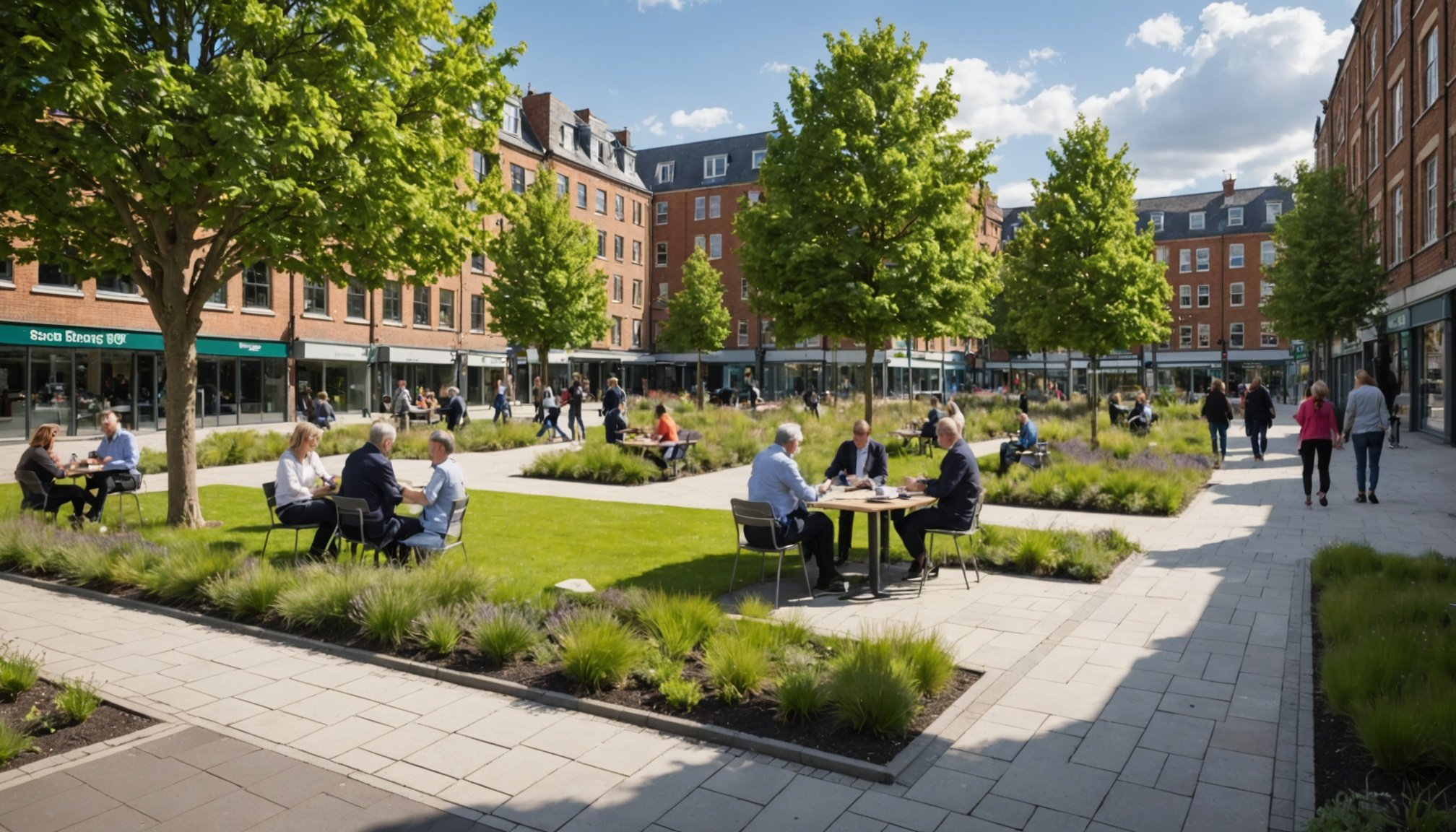The Concept of Community-Focused Smart Parks
Community-centric parks play a pivotal role in urban planning, transforming traditional urban green spaces into integrated smart park concepts designed around the needs of the community. These parks serve as lush sanctuaries amidst bustling city life, providing a sense of escape while enhancing the quality of urban living. The significance of these spaces is captured by their ability to adapt and address specific community demands, from recreational facilities to eco-friendly initiatives.
Understanding the importance of integrating community needs into park design is crucial. When local residents express desires for particular amenities or eco-technological features, responsive urban planning can incorporate these elements, making the park more relevant and useful to the people it serves. This can include fitness stations, children’s play areas, or Wi-Fi connectivity for remote work and leisure, demonstrating how these spaces support diverse activities and foster community interaction.
This might interest you : Revamping city travel: leveraging big data to transform public transportation in uk urban areas
The evolution of urban green spaces into smart parks is driving a new wave of urban development. This transformation is not merely aesthetic but functional, involving the incorporation of technology to monitor and maintain the environment, optimize resource use, and ensure safety. Such enhancements contribute to both sustainability and an improved user experience, cementing smart parks as essential components for future-proof urban landscapes. The synergy between the natural environment and technology accentuates how these innovative spaces can potentially redefine city life.
Benefits of Smart Parks on Public Health and Well-Being
Urban parks have long been recognized as pivotal spaces for enhancing public health benefits and well-being. With the advent of “smart parks,” these benefits have become even more pronounced. Smart parks utilize technology to promote mental health by providing serene environments that encourage relaxation and stress reduction. Numerous studies indicate that access to green spaces significantly boosts mental health, reducing symptoms of anxiety and depression.
In the same genre : Transforming Precision: The Impact of Robotics on Manufacturing Excellence in the UK
Moreover, these parks are designed to increase physical activity. They often incorporate features such as smart trails that track fitness data and interactive playgrounds that motivate users to move. Enhanced physical activity is directly linked to improved well-being, decreasing the risks of chronic illnesses and enhancing overall life satisfaction.
Smart parks also engage communities effectively, fostering a sense of belonging and shared responsibility. Through digital tools like community apps or interactive boards, residents can participate in park activities or even in the park’s development process. Community engagement not only strengthens social ties but also promotes emotional and mental health, highlighting the critical role of these parks in supporting comprehensive well-being.
Design Principles for Community Engagement
Fostering effective community interaction and engagement begins with recognizing the importance of design principles tailored to communal needs. Key design elements must prioritize accessibility, inclusivity, and flexibility. Spaces designed with these features encourage broader community use and interaction, creating environments where individuals feel welcomed and valued.
Central to this approach is participatory design, an essential tool in crafting user-centered parks. This involves direct collaboration with community members throughout the design process, ensuring their perspectives and needs are fully integrated. By engaging local residents, designers can create spaces that truly reflect the desires and requirements of the community.
To successfully embed community feedback into design processes, clear strategies must be established. This includes regular consultation sessions, workshops, and surveys, providing multiple platforms for community input. Ensuring ongoing dialogue between designers and the community helps maintain a focus on responsive and adaptable design solutions, ultimately fostering a deep connection between the space and its users.
Technological Integrations in Smart Parks
Integrating technology in parks plays a pivotal role in enhancing visitor experiences and maintaining park ecosystems. For instance, IoT parks utilize devices such as sensors and drones to gather data on weather conditions, wildlife activities, and visitor movement. This information helps park management optimize both resource allocation and visitor engagement.
Common technologies in smart park designs include interactive kiosks, augmented reality apps, and Wi-Fi hotspots, all aimed at improving accessibility and engagement through seamless connectivity. Such innovations allow visitors to access interactive maps, educational content, and real-time park updates, enriching their overall experience.
One key aspect is maintaining a balance between technological interventions and preserving natural elements. While technology enables innovative solutions and efficiencies, it’s crucial to design smart parks that minimize the ecological footprint. By strategically placing IoT devices to monitor and protect fragile habitats, park management ensures that the natural beauty remains the focal point, while technology serves as an unobtrusive aid. This synergy highlights how smart technologies can harmonize with nature to create sustainable and engaging environments for all.
Case Studies from the UK
In recent years, the UK has become a hub for smart park case studies, showcasing a wave of innovative solutions aimed at enhancing recreational spaces. These successful implementations have transformed ordinary parks into interactive environments that engage communities while promoting sustainability.
One of the notable UK examples is the Smart Park in Milton Keynes. This project integrates IoT sensors and AI technology to efficiently manage energy consumption and provide real-time data on park usage. It has significantly improved the visitor experience by providing Wi-Fi hotspots and interactive kiosks.
The community impact of these projects is profound. Residents have reported increased park usage, fostering a sense of community engagement and improving public health. Moreover, the parks have become educational platforms for schools and families, demonstrating the practical applications of technology in everyday life.
From these case studies, several lessons learned emerge. Firstly, effective collaboration between local authorities, technology providers, and the community is essential for success. Secondly, consistent maintenance and updates are crucial to ensure the technology meets its potential. Lastly, flexibility in design allows parks to adapt to future technological advancements.
Best practices include incorporating user feedback into the design process and ensuring accessibility for individuals with disabilities. These strategies not only optimize the visitor experience but also ensure that the benefits of smart parks are inclusive and widespread.
Planning and Funding Strategies for Smart Parks
Creating a smart park involves meticulous park planning that focuses on community needs and evolving technology. To start, thorough project proposals should be developed, encapsulating the vision of community-focused amenities, technological integrations, and sustainability goals. These proposals serve as blueprints for subsequent actions, such as engaging stakeholders and securing necessary permissions.
Securing funding for smart parks is a critical next step. Effective strategies include tapping into a mix of public funds, grants, and private investments. Local government units often provide initial funding, but expanding sources to include regional and national grants will bolster the financial base. Additionally, partnerships with local businesses and tech companies can provide both funding and the technological expertise needed.
Collaborating with local organizations enhances the community connection and resource pool. These partnerships are crucial, as they may offer ongoing support and ensure the park serves the community’s long-term needs. Navigation of these avenues requires clarity in approach, ensuring every proposal and partnership aligns with broader municipal development plans.
Visual Elements and Statistics Supporting Smart Parks
Visual data plays a pivotal role in illustrating the impact and advantages of smart parks. By leveraging compelling graphics, communities can better understand how technology transforms public spaces and enhances community well-being. Infographics and charts depicting sensor data or usage patterns highlight areas for improvement and underscore the tangible benefits such as increased safety and efficient resource management.
Key statistics bolster the argument for community-focused smart park initiatives. For example, data may reveal that parks with integrated lighting and surveillance systems see a 30% reduction in vandalism, promoting a safer environment. Metrics on usage can illustrate sustained park engagement, driving home the positive benefits of implementing smart technologies. These figures empower stakeholders to make informed decisions that align with community priorities and expectations.
Evidence-based park design is fundamental to smart park development. Through careful data collection and analysis, stakeholders can tailor features to meet specific community needs. This approach ensures that investments are justified and that park facilities continue to evolve based on actual user behavior. In this way, statistics not only validate the adoption of technological enhancements but also guide future innovations by providing a clear, data-driven roadmap for improvement.
Expert Interviews and Insights
Gleaning perspectives from expert opinions in urban design and public health provides significant insight into the development of sustainable and smart park environments. A compilation of insights reveals a collective vision, where urban landscapes are seen not just as spaces for relaxation but as vital components of public health infrastructure.
Interviews with leading figures emphasize the importance of technology and nature coexisting harmoniously. Experts project that future park design will leverage smart technologies—such as IoT devices and data analytics—to enhance community engagement and environmental sustainability. This trend points to a future where parks can adapt dynamically to the needs of the community, promoting both physical and mental well-being.
Moreover, these park design insights underline the critical role of community involvement. Professionals argue that engaging local communities in the design process is paramount. By incorporating public feedback, park planners can ensure the spaces reflect local needs and preferences, making parks more inclusive and accessible.
These discussions underscore a pivotal shift in urban planning, advocating for more collaborative and innovative approaches to park development. This will ultimately foster a healthier and more connected urban populace.






